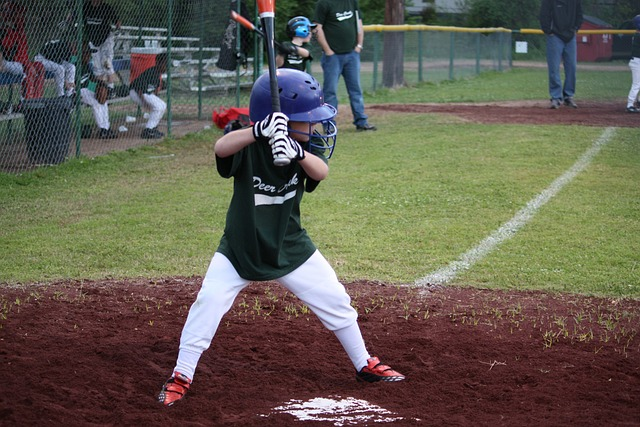
Baseball is often referred to as a game of numbers, and it's not hard to see why. Whether you're a player or a fan, statistics are an essential part of understanding the game. Two of the most important metrics for hitters are batting average and on-base percentage, both of which are widely used to measure a player's offensive success.
Batting average, often abbreviated as "BA," is a straightforward calculation that divides a player's total number of hits by their total number of at-bats. This simple formula has been used for generations and is still widely relied upon by many fans and analysts to assess a player's ability at the plate. However, while batting average is a useful statistic, it does have limitations. For example, it doesn't take into account walks or hit-by-pitches, both of which can have a significant impact on a game's outcome.
Additional Reading: What is a Good Batting Average in Baseball?
On-base percentage, or "OBP," takes a more comprehensive approach to evaluating a player's offensive performance. This stat measures the percentage of times a player reaches base safely, whether by a hit, walk, or hit-by-pitch. It's a more inclusive metric than batting average, as it accounts for all the ways a player can reach base and help their team. In other words, OBP provides a better reflection of a player's overall offensive contribution.
So which is more important in baseball, batting average or on-base percentage? The answer is not straightforward. While batting average has long been a staple of baseball statistics, many analysts argue that OBP is a more accurate indicator of a player's offensive value. In fact, some baseball experts have created a hybrid metric, called OPS (On-Base Plus Slugging), which combines both OBP and slugging percentage to provide a more complete picture of a player's offensive production.
Whether you're a seasoned fan or new to the game, understanding the differences between batting average and on-base percentage can help you appreciate the nuances of the sport. By evaluating players based on both metrics, you can gain a more comprehensive understanding of their strengths and weaknesses. So the next time you watch a game, pay attention to more than just batting average - on-base percentage and other relevant stats can provide a more complete picture of a player's contribution to their team's success.

Batting average and on-base percentage are two statistics that are often used to evaluate a player or major league team's performance in baseball. While both statistics are related to a player's ability to get on base, they are calculated differently and can provide different insights into a player or major league team's performance.
Batting average is calculated by dividing a player's total number of hits by their total number of at-bats. This statistic provides a measure of a player's ability to make contact with the ball and get a hit.
On-base percentage, on the other hand, a similar stat that takes into account not only the total bases a player's hits but also their walks and hit-by-pitches. It is calculated by dividing the total number of times a player reaches base (hits, walks, and hit-by-pitches) by their total number of plate appearances.
While batting average is a simple and straightforward statistic, it doesn't take into account a player's ability to draw walks or get hit by pitches, which can also contribute to their value as a hitter. On-base percentage, on the other hand, provides a more complete picture of a player's ability to get on base and contribute to their team's offense.
In the next sections, we will take a closer look at the differences between these two statistics and discuss which one is more important in evaluating a player's performance.

When it comes to comparing batting average and on-base percentage, it's important to understand the fundamental difference between the two statistics. Batting average is simply the number of hits divided by the total number of at-bats. On the other hand, on-base percentage takes into account not only hits but also walks and hit-by-pitches.
While batting average is often used as a quick way to gauge a player's hitting ability, it doesn't tell the whole story. For example, a player may have a high batting average but a low on-base percentage if they rarely walk or get hit by pitches. This means while better than batting average, they are not contributing to the team's overall offensive production as much as someone with a lower batting average but a higher on-base percentage.
On the other hand, a player with a high on-base percentage but a low batting average may not get as many hits, but they are still getting on base and putting pressure on the opposing team's defense. They are also more likely to score runs and help their team win games.
So, while both statistics have their merits, on-base percentage is generally considered to be a more complete measure of a player's offensive contribution. It takes into account not just hits, but also walks and hit-by-pitches, which can significantly impact a team's ability to score runs.
In the next section, we'll dive deeper into the specific differences between batting average and on-base percentage and how they can impact a team's overall performance.

When it comes to determining the importance of batting average and on-base percentage, the answer is not a simple one. Both statistics have their merits and limitations, and the answer ultimately depends on the context in which they are being used.
Batting average has traditionally been seen as a key measure of a player's offensive prowess. It is calculated by dividing a player's total number of hits by their total number of at-bats. This gives us a number that represents the player's ability to get a hit when they come to bat. A high batting average is generally seen as a positive thing, as it suggests that the player is consistently making contact with the ball and getting on base.
On-base percentage, on the other hand, takes into account all of the ways a player can reach base. In addition to hits, it includes base on balls, hit-by-pitches, and other situations per plate appearance in which a player safely reaches base. It is calculated by dividing the player's total number of times on base (hits, walks, hit-by-pitches) by their total number of plate appearances. Because it includes more ways of reaching base than batting average, it is often seen as a more comprehensive measure of a player's offensive contribution.
So which is more important? The answer depends on the situation. In some cases, a high batting average might be more valuable. For example, in a situation where a runner is already on base, a player with a high batting average might be more likely to drive them in with a hit. On the other hand, in a situation where there are no runners on base, a player with a high on-base percentage might be more valuable, as they are more likely to get on base and start a rally.
Ultimately, both statistics have their place in evaluating a player's performance, and it's important to consider them in context. A player with a high batting average and a low on-base percentage might not be as valuable as a player with a lower batting average but a higher on-base percentage, depending on the situation. It's important to look beyond the raw numbers and consider the context in which they were achieved.

When it comes to measuring a baseball player or power hitter's offensive prowess, batting average and on-base percentage are just two of several statistics that are commonly used. Here are a few other stats that can be relevant in evaluating a player's performance at the plate:
This stat measures the total number of bases a player has gained per at-bat, with extra weight given to extra-base hits. Like batting average, slugging percentage is calculated by dividing the total number of bases by the total number of at-bats. SLG percentage and batting averages can give a good insight into a player's power and hitters ability.
OPS, or on-base plus slugging, is a statistic used in baseball that takes into account a player's ability to both get on base and hit for power. This is done by combining a player's on-base percentage, which measures how often they reach base safely, and slugging percentage, which measures their ability to hit for extra bases. By combining these two stats, OPS provides a more complete picture of a player's overall offensive production than either stat alone could. OPS has become an increasingly popular stat among baseball analysts and fans because it provides a simple yet powerful way to evaluate a player's offensive contributions.
Weighted On-Base Average (wOBA) is a more advanced and comprehensive statistic that aims to provide a more accurate representation of a player's true offensive value than batting average or on-base percentage alone. It achieves this by taking into account the run-scoring value of each possible outcome of an at-bat, assigning a league average of value to each one. For example, a home run is worth more than a single, and a walk is worth less than a double.
The weighted average is calculated by adding up the total value of a player's at-bats and dividing it by their total plate appearances. This provides a more complete picture of their overall offensive production because it takes into account both their ability to get on base and their ability to hit for power.
By combining a player's on-base percentage and slugging percentage into one statistic, wOBA provides a more accurate representation of a player's offensive ability than other statistics. This is particularly useful when comparing players who play the same position in different parks or leagues, as it adjusts for differences in run-scoring environments.
This is a comprehensive statistic that attempts to measure a player's total value to their team, taking into account both their offensive output and defensive contributions as well as position played.
While batting average and on-base percentage are certainly important stats to consider when evaluating a player's performance at the plate, they are by no means the only ones. By looking at a broader range of statistics, fans and analysts can gain a more nuanced understanding of a player's overall offensive contribution.

In conclusion, both batting average and on-base percentage are important statistics in baseball, but they serve different purposes. Batting average is a good measure of a player's ability to get hits, while on-base percentage takes into account the player's obp and ability to reach base in other ways, such as walks and hit-by-pitches.
When evaluating a player's overall offensive ability, it's important to look at both statistics in conjunction with other relevant stats, such as slugging percentage and OPS. Each statistic provides a different perspective on a player's performance, and no one statistic, like batting average or earned run average, should be used in isolation to make judgments.
Ultimately, the choice between batting average and on-base percentage as the more important statistic depends on the context and what you're trying to measure. Both have their strengths and weaknesses, and a good average well-rounded understanding of both is crucial to evaluating a player's overall offensive impact.
In summary, understanding the difference between batting average and on-base percentage is essential for anyone looking to analyze a baseball players' statistics. Both have their place in evaluating a player's offensive performance, and knowing when and how to use them is key. With a thorough understanding of these statistics and other relevant metrics, you can gain a deeper appreciation for the game of baseball and the players who play it.

Chris Sloan is a former baseball league commissioner and travel baseball coach who has made significant contributions to the sport. In 2018, he founded selectbaseballteams.com, a website that helps parents find youth and travel baseball teams in their local areas. Since its launch, the website has experienced impressive growth, offering a wealth of resources including teams, news, tournaments, and organizations. Chris's unwavering passion for baseball and his innovative approach to connecting parents with quality baseball programs have earned him a respected reputation in the baseball community, solidifying his legacy as a leading figure in the world of youth and travel baseball.
There are 0 comments on "Batting Average vs. On-Base Percentage: Which Statistic is More Important in Baseball?"
chandler allen says:
"Hi my name is chandler, i’ve enjoyed..."
On Wanting to tryout for summer ball. as an 18 year old
david graham says:
"With no current MLB team in Canada,..."
On With no current MLB team in
Charles Chavez says:
"To All Coaches: Do you have13U or..."
On Looking for Games